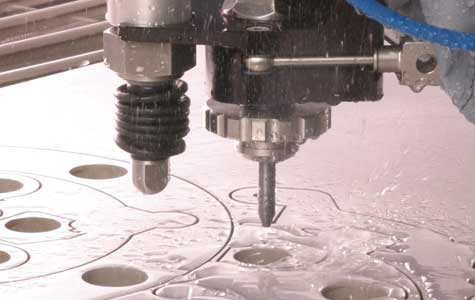WaterJet Machining Hydrodynamic Machining Review
WaterJet Machining Hydrodynamic Machining Review
Waterjet Machining uses a high velocity narrow jet of a liquid (water) to cut materials. The jet of liquid velocity is about 2000 ft/sec. Material is eroded from the work piece at the impact location of the liquid jet. The liquid pressure at the impact area is approximately 60,000 psi. Typical cut path removal is approximately .002 to .040 wide. One can cut virtually any 2D shape with CNC control directing the water jet location.
 |
|---|
Waterjet machining can machine virtually any material, one can even water jet cut material after it has been heat treated. Typically, the difference between cutting material before heat treat vs. after is negligible to an water jet. Water jets are very capable for exotic materials like Inconel, Hastalloy, Titanium, etc.
Limitations to the shape: The minimum inside radius an abrasive jet can cut is about 0.015" (0.38mm) on most machines. Higher power machines may require a minimum radius of up to 0.030" (0.75mm). Smaller radii such as 0.01" (0.25mm) can be machined with special nozzles. You can make a hole that is as small as the diameter of the nozzle. This means 0.030" to 0.060" (0.75mm- 1.5mm). However, in thicker materials, the tolerance on such holes becomes increasingly difficult to maintain.
An important benefit of the water jet cutter is the ability to cut material without interfering with the material's inherent structure as there is no "heat-affected zone" or HAZ. Minimizing the effects of heat allows metals to be cut without harming or changing intrinsic properties.
 |
| 1 - high-pressure water inlet 2 - jewel (ruby or diamond) 3 - abrasive (garnet) 4 - mixing tube 5 - guard 6 - cutting water jet 7 - cut material |
Water jet cutters are also capable of producing rather intricate cuts in material. The kerf, or width, of the cut can be changed by changing parts in the nozzle, as well as the type and size of abrasive. Typical abrasive cuts are made with a kerf in the range of 0.04" to 0.05" (1.016 to 1.27 mm), but can be as narrow as 0.02" (0.508 mm). Non-abrasive cuts are normally 0.007" to 0.013" (0.178 to 0.33 mm), but can be as small as 0.003" (0.076 mm), which is approximately the size of a human hair. These small cutters can make very small detail possible in a wide range of applications.
Water jet is considered a "green" technology. Water jets produce no hazardous waste, reducing waste disposal costs. They can cut off large pieces of reusable scrap material that might have been lost using traditional cutting methods. Parts can be closely nested to maximize material use, and the water jet saves material by creating very little kerf. Water jets use very little water (a half gallon to approximately one gallon per minute depending on cutting head orifice size), and the water that is used can be recycled using a closed-looped system. Waste water usually is clean enough to filter and dispose of down a drain. The garnet abrasive is a non-toxic natural substance that can be recycled for repeated use. Garnet usually can be disposed of in a landfill. Water jets also eliminate airborne dust particles, smoke, fumes, and contaminates from cutting materials such as asbestos and fiberglass. This greatly improves the work environment and reduces problems arising from operator exposure.
Because the nature of the cutting stream can be easily modified the water jet can be used in nearly every industry; there are many different materials that the water jet can cut. Some of them have unique characteristics that require special attention when cutting. Each material cut will have some unique characteristics that have to be taken into account.
Materials commonly cut with a water jet include rubber, foam, plastics, composites, stone, tile, metals, food, paper and much more. Materials that cannot be cut with a water jet are tempered glass, diamonds and certain ceramics.
Water jet cuts are not typically limited by the thickness of the material, and are capable of cutting materials over eighteen inches (45 cm) thick. The penetrating power of these tools has led to the exploration of their use as anti-tank weapons but, due to their short range and the advent of composite armour, research was discontinued.